ISSN ONLINE(2319-8753)PRINT(2347-6710)
ISSN ONLINE(2319-8753)PRINT(2347-6710)
Shyamala Viswanathan1, Ebciba. C2, Santhiya. R2 Thangaraju Nallamuthu3
|
| Related article at Pubmed, Scholar Google |
Visit for more related articles at International Journal of Innovative Research in Science, Engineering and Technology
Marine natural products have attracted the attention of biologists and chemists the world over for the last five decades. The active metabolites, also known as biogenic compounds, produced by several species of marine macro- and micro-algae, have antibacterial, antialgal, antimacro fouling and antifungal properties, which are effective in the prevention of cancer, and many other diseases have other likely uses, e.g. in therapeutics. The common major compounds like proteins, carbohydrates, steroids, glycosides can be extracted using polar solvents such as Methanol, Ethyl acetate and Hexane during Phytochemical process. These results were compared with the recently reported qualitative phytochemical tests which were used to detect the presence of alkaloids, tannins, saponins, flavonoids, glycosides and phenols from the seaweeds. Of the three solvents tested, Methanol was determined to be the best solvent for isolation of antimicrobial compounds from the tested marine algae followed by Ethyl acetate and Hexane. Among marine the algal extracts tested, some appeared to be specific in their activity against several tested bacteria. This point may be important for the development of specific antibiotics, and further work is needed to identify the compounds causing the activity, to evaluate specific antimicrobial activity against pathogenic bacteria especially those causing the human diseases.
Keywords |
| Amphiroa fragilissima, Methanol extract Ethyl acetate extract, Chloroform extract, Human pathogenic bacteria and MTT assay |
INTRODUCTION |
| Algae are found everywhere on earth: in the sea, rivers and lakes, on soil and walls, in animal and plants (as symbionts-partners collaborating together); in fact just about everywhere where there is a light to carry out photosynthesis. Seaweeds are marine plants, divided into three categories based on their colors, such as red (4,500 species), green (900 species) and brown (1,000 species). These organisms constitute a total of 25-30,000 species, with a great diversity of forms and sizes, and that can exist from unicellular microscopic organisms (microalgae) to multi cellular of great size (macro algae). |
| Seaweeds are considered as a source of bioactive compounds as they are able to produce a great variety of secondary metabolites characterized by a broad spectrum of biological activities. The environment in which seaweeds grow is harsh as they are exposed to a combination of light and high oxygen concentrations. These factors can lead to the formation of free radicals and other strong oxidizing agents but seaweeds seldom suffer any serious photodynamic damage during metabolism. This fact implies that seaweed cells have some protective mechanisms and compounds (Matasukawa et al.,1997).The total global seaweed production of the world in the year 2004 was >15 million metric tons of which nearly 15–20% is contributed by Indian Ocean region (FAO,2006). Extensive screening of marine microalgae has led to the isolation and chemical determination of over 15, 000 compounds, including fatty acids, sterols, phenolic compounds, terpenes, enzymes, polysaccharides, alkaloids, and flavonoids. More recent reports revealed that marine algae possess rich sources of antioxidant compounds with potential free radical scavenging activity. |
| Reactive oxygen species (ROS) such as hydroxyl, superoxide and peroxyl radicals are formed in human cells by endogenous factors and result in extensive oxidative damage which can lead to age related degenerative conditions, these include cancer, cardiovascular disease, artherosclerosis, hypertension, ischemia /re-perfusion, diabetes mellitus, hyperoxaluria, neuro degenerative disease such as Alzheimer’s and Parkinson’s disease and ageing (Cerutti 1985, Borek 1993 ,Hercberg et al., 1998 and Halliwell 2009 ). |
| Phenolic compounds can act as antioxidants by chelating metal ions, preventing radical formation and improving the antioxidant endogenous system. The term “phenolic compound” describes several hundred molecules found in edible plants that possess on their structure a benzenic ring substituted by, at least, one hydroxyl group (Manach et al., 2004). Antimicrobial has increased in recent years in order to reduce the use of synthetic forms such as Butylated Hydroxyanisole (BHA) and Butylated Hydroxytoluene (BHT). Natural antioxidants from plant origin can react rapidly with these free radicals and retard or alleviate the extent of oxidative deterioration (Akoh and Min, 1997). Furthermore, antioxidants from natural sources can also increase the shelf life of foods. Therefore, the consumption of antioxidant and/or addition of antioxidant to food materials could protect the body as well as the foods against these events (Chandini et al., 2008). Tannins are defined as naturally occurring plant polyphenolic compounds and are widespread among terrestrial and marine plants (Haslam, 1989, Waterman and Mole, 1994). Flavonoids, the largest group of phenolic compounds is known to contain a broad spectrum of chemical and biological activities including antioxidant and free radical scavenging properties (Kahkonen et al., 1999). |
| Cancer is one of the most serious threats to human health in the world and chemotherapy is still the standard treatment method. Most of the anticancer drugs currently used in chemotherapy are cytotoxic to normal cells and cause immunotoxicity which affects not only tumor development, but also aggravates patient’s recovery. The discovery and identification of new antitumor drugs with low side-effects on immune system has become an essential goal in many studies of immunopharmacology (Xu et al., 2009). More attention has been paid to natural compounds in plants and micro organisms. Regarding the less side-effects of plants and other natural compounds, scientists are interested in working on them to find new medications. |
MATERIALS AND METHODS |
| COLLECTION OF SEAWEEDS |
| Amphiroa fragilissima (Linnaeus) J.V. Lamouroux (1816) were collected from the coast of Kilakarai, Rameswaram, Tamilnadu on 11th November, 2012. After thoroughly washing with sea water, manual sorting was done to remove epiphytes, was exhaustively washed first with tap water and then with distilled water. The seaweeds were shade-dried and ground to fine powder. |
| EXTRACTION OF SEAWEEDS |
| Twenty grams of the dried powdered seaweed material were extracted separately in 100 mL of Chloroform, Ethyl acetate and Methanol for 3 days. Then the whole extracts were decanted and filtered using Whatmann No.1 filter paper. This process was repeated three times for each solvent. The filtrates obtained were concentrated under vacuum with rotary evaporator at 40ºC to obtain the crude extracts. The extracts were subsequently freeze dried and used for further studies. |
| QUALITATIVE PHYTOCHEMICAL ANALYSIS |
| The different qualitative chemical tests were performed for establishing profile of the given extracts for their chemical composition. |
| ANTIBACTERIAL ASSAY |
| MEDIUM USED |
| Nutrient Agar medium and broth were used for the screening of antibacterial activity of the seaweed extracts. |
| PREPARATION OF INOCULUM |
| The stock cultures were maintained at 4ºC on the slant slopes of nutrient agar medium. Active cultures for experiments were prepared by transferring a loopful of cells from the stock cultures to test tubes of Mueller Hinton Broth (MHB) that were incubated without agitation for 24 hrs at 37º C. To 5 mL of MHB, 0.2 mL of culture was inoculated and incubated till it reached the turbidity equal to that of the standard 0.5 Mc Farland solution at 600 nm which is equivalent to 106-108 CFU /mL. |
| TEST ORGANISMS |
| The test organisms were collected from the Department of Medical Microbiology, University of Madras, Taramani campus, Chennai- 600 113, Tamil Nadu, India. The two gram positive: viz., Staphylococcus aureus and Bacillus subtilis, three gram negative: viz., Escherichia coli, Pseudomonas aeruginosa and Klebsiella pneumonia were used in the present study. |
| AGAR WELL DIFFUSION METHOD |
| The antibacterial activity of seaweed extracts of A. fragilissima obtained with Chloroform, Ethyl acetate and Methanol were evaluated by the agar well diffusion method (Deena and Thoppil, 2000). The strains that had been incubated for 24 hrs for bacteria were used for the assay. A sterile cotton swab was dipped into the bacterial suspension and then evenly streaked over the entire surface of a sterile Mueller Hinton Agar plate to obtain uniform inoculums. The wells were punched on the seeded plates using a sterile borer (7 mm), and the plates were allowed to dry for 5 mins. The solvent extraction of hexane, ethyl acetate and methanol extracts (75 μL, 100 μL and 150 μL) were dispensed into each well using a sterile micropipette. The Dimethyl Sulfoxide (DMSO) was used as a negative control and Streptomycin (10 μL) was used as positive control. The plates were incubated overnight for bacteria at 37°C. The antibacterial activity was determined by measuring the diameter of zone of inhibition (mm). |
| ESTIMATION OF TOTAL PHENOL CONTENT (Taga et al., 1984). |
| The total phenolic concentration was measured using the Folin-Ciocalteau method (Taga et al., 1984). In this procedure, 100 μl aliquot of stock sample (extract concentration 1000 μg/ml of water) was mixed with 2.0 ml of 2% Na2CO3 and allowed to stand for 2 min at room temperature. Then 100 μl of 50% Folin-Ciocalteau phenol reagent was added. After incubation for 30 min at room temperature in darkness, the absorbance was read at 720 nm using spectrophotometer (Milton Roy Spectronic 1201). The total phenolic contents of the samples were expressed as mg Gallic acid equivalent per gram (mg GAE/g). Ascorbic acid was used as a positive control. |
| ESTIMATION OF TOTAL TANNIN CONTENT (Julkunen-Titto 1985) |
| Total condensed tannin content was determined according to the method of Julkunen-Titto (1985). Briefly, a 50 μl aliquot of each extract was mixed with 1.5 ml of 4% vanillin (prepared with methanol) and then 750 μl of concentrated HCl was added. The solution was shaken vigorously and left to stand at room temperature for 20 min in darkness. Absorbance against blank was read at 500nm. (+)-catechin was used to prepare the standard curve and results were expressed as mg catechin equivalents (CE)/g extract. |
| ESTIMATION OF TOTAL FLAVONOID CONTENT (Zhishen et al., 1999). |
| Total flavonoid content was determined according to the method of Zhishen et al., (1999). Briefly, a 250 μl aliquot of each extract was mixed with 1.25 ml of double distilled (dd) H2O and 75 μl of 5% NaNO2 solution. After 6 min, 150 μl of 10% AlCl3.H2O solution was added. After 5 min, 0.5 ml of 1 M NaOH solution was added and then the total volume was made up to 2.5 ml with dd H2O. Following thorough mixing of the solution, the absorbance against blank was determined at 510 nm. Quercetin was used to prepare the standard curve and results were expressed as mg Quercetin equivalents (QE)/g extract. |
| EVALUATION OF IN VITRO ANTIOXIDANT ASSAY |
| DPPH RADICAL SCAVENGING ASSAY |
| 2-picryl-hydrazyl (DPPH) following the method of Hong et al., 2008. 0.1 mM solution of DPPH in methanol was prepared and 1ml of this solution was added to 3 ml of seaweed extracts at different concentrations (50, 75, 100, 150 and 200 μg/mL). After 10 min, absorbance was measured at 517 nm. The percentage scavenging activity values were calculated as below: |
| % of scavenging = ((Ao-A1) /Ao) x 100 |
| Where Ao is absorbance of control and A1 is absorbance of sample turbidity factor. |
| ESTIMATION OF REDUCING POWER |
| Reducing power of the extract was determined by the following method of Yamaguchi et al., 1998. 0.75 ml of extract at various concentrations (50, 75, 100, 150 and 200 μg/mL) was mixed with 0.75 ml phosphate buffer (pH 6.6) and 0.75ml of 1% potassium ferricyanide was added. The mixture was incubated at 50°C for 20 min. 0.75 ml of 10% trichloroacetic acid was added to the mixture and centrifuged at 3000 g for 10 min. 1.5 ml of the supernatant was mixed with 1.5 ml of distilled water and 0.1ml of 0.1% ferric chloride. The absorbance was read at 700 nm after 10 min of incubation. |
| HYDROGEN PEROXIDE SCAVENGING ASSAY |
| The free radical scavenging activity of the extract was determined by Hydrogen peroxide assay Gulcin et al., 2004. Hydrogen peroxide (10 mM) solution was prepared in phosphate buffered saline (0.1M, pH 7.4). 1ml of the extract (50, 75, 100, 150 and 200 μg/mL)) was rapidly mixed with 2 ml of hydrogen peroxide solution. The absorbance was measured at 230 nm in the UV spectrophotometer after 10 min of incubation at 37oC against a blank (without hydrogen peroxide). The percentage of scavenging of hydrogen peroxide was calculated using the formula |
| % of scavenging = ((Ao-A1) / Ao) x 100 |
| Where Ao is absorbance of control and A1 is absorbance of sample. |
| DETERMINATION OF TOTAL ANTIOXIDANT CAPACITY (TAC) |
| Total antioxidant activity of seaweed extract was determined according to the method of Mitsuda et al., 1996. 7.45 ml of sulphuric acid (0.6M), 0.99g of sodium sulfate (28mM) and 1.23g of ammonium molybdate (4mM) were mixed together in 250ml with distilled water and labeled as Total Antioxidant Capacity (TAC). 0.1 ml of the seaweed extract (50, 75, 100, 150 and 200 μg/mL)) was dissolved in 1ml of TAC and the absorbance was read at 695 nm after 15 min. Ascorbic acid was used as standard. |
| ABTS INHIBITION ASSAY |
| The free radical scavenging activity was also determined by ABTS (2, 2’azino bis (3-ethylbenzothiazoline-6- sulphonicacid) diammonium salt) radical cation decolourization assay Re et al., 1999. ABTS was generated by mixing 5 ml of 7 mM ABTS with 88 μL of 140 mM potassium per sulfate under darkness at room temperature for 16 h. The solution was diluted with 50% ethanol and the absorbance at 734 nm was measured. The ABTS radical cation scavenging activity was assessed by mixing 5 ml ABTS solution (absorbance of 0.7 ± 0.05) with 0.1 ml seaweed extract (50, 75, 100, 150 and 200 μg/mL) of scavenging was calculated by the following formula % of scavenging = ((Ao-A1) / Ao) x 100 |
| Where Ao is absorbance of control and A1 is absorbance of sample. |
| METAL ION-CHELATING ABILITY ASSAY |
| The chelating ability of ferrous ion (FIC) by red seaweed was estimated by the original method of Decker and Welch (1990) with minor modifications. This assay is based upon the formation of blue colored ferrous ion-ferrozine complex which has a maximum absorbance at 562 nm. Briefly, 100 mL of varying concentrations of different extract samples and standard were mixed with 100 mL of deionized water and 25 mL of ferrous chloride (0.5 mM) in a microtiter plate. The reaction was initiated by the addition of 25 mL of ferrozine (2.5 mM), and the reaction mixture was shaken vigorously. The absorbance was recorded at 562 nm with a microtiter plate reader, after 10 min of incubation at ambient temperature. Ethylenediaminetetraaceticacid acid (EDTA) was used as a standard compound. The percentage of inhibition of ferrozine-Fe2+ complex formation was calculated. |
| ANTICANCER ACTIVITY OF METHANOL EXTRACT OF A. fragilissima |
| Cell line and culture |
| Lung Cancer-A549 cell lines was obtained from Tamil Nadu Veterinary College, Chennai. The cells were maintained in Minimal Essential Media supplemented with 10% FBS, penicillin (100 U/ml), and streptomycin (100 μg/ml) in a humidified atmosphere of 50 μg/ml CO2 at 37 °C. |
| Reagents |
| MEM was purchased from Hi Media Laboratories Fetal bovine serum (FBS) was purchased from Cistron laboratories Trypsin, methylthiazolyl diphenyl- tetrazolium bromide (MTT), and Dimethyl sulfoxide (DMSO) were purchased from (Sisco research laboratory chemicals Mumbai). All of other chemicals and reagents were obtained from Sigma Aldrich Mumbai. |
| In vitro assay for Cytotoxicity activity (MTT assay) |
| The Cytotoxicity of samples on A549 was determined by the MTT assay (Mosmann 1983). Cells (1 × 105/well) were plated in 1ml of medium/well in 24-well plates (Costar Corning, Rochester, NY). After 48 hours incubation the cell reaches the confluence. Then, cells were incubated in the presence of various concentrations of the samples in 0.1% DMSO for 48h at 37°C. After removal of the sample solution and washing with phosphate-buffered saline (pH 7.4), 200μl/well (5mg/ml) of 0.5% 3-(4, 5-dimethyl-2-thiazolyl)-2, 5-diphenyl--tetrazolium bromide cells (MTT) solution was added. After 4h incubation, 0.04M HCl/ isopropanol were added. Viable cells were determined by the absorbance at 570nm. Measurements were performed and the concentration required for a 50% inhibition of viability (IC50) was determined graphically. The absorbance at 570 nm was measured with a UV- Spectrophotometer using wells without sample containing cells as blanks. The effect of the samples on the proliferation of A549 was expressed as the % cell viability, using the following formula: |
| % cell viability = A570 of treated cells / A570 of control cells × 100%. |
RESULTS |
| In the present study, the seaweed Amphiroa fragilissima is selected and screened for the presence of phytochemical constituents. The phytochemical constituents such as alcohols, flavonoids, tannins, phenols, saponins and several other aromatic compounds are secondary metabolites of seaweed that serve as defense mechanism against predation by many microorganisms, insects and other herbivores. The present study carried out on the seaweed sample revealed the presence of medicinally active constituents. The phytochemical constituents of the selected seaweed investigated are summarized in (Table 1). The seaweed extracts have been analyzed and revealed the presence of flavonoids, glycosides, phenols, carbohydrates, saponins, and tannins of selected seaweeds, which could be responsible for the observed antibacterial property. |
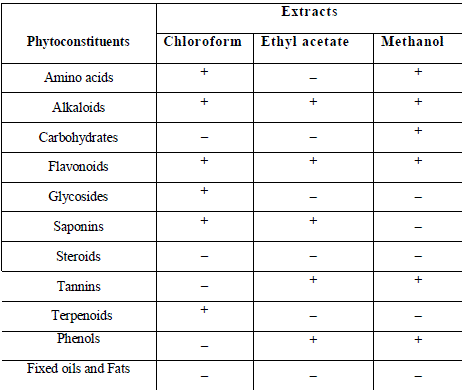 |
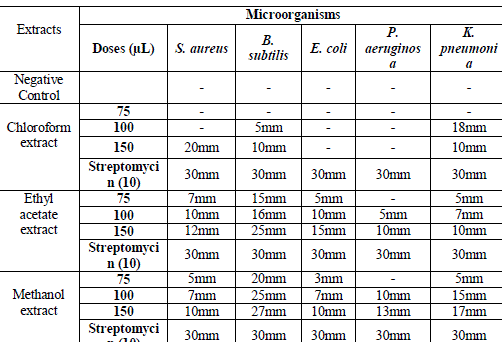 |
| The bacterial infection is the most serious global health issue in the 21st century. The different solvent extracts of Amphiroa fragilissima were tested against the human pathogenic microbes’ viz., Staphylococcus aureus, and wound infecting pathogen which can cause specticemia, endocardiac and toxic shock syndrome. Bacillus subtilis , immunostimulatory agent, Escherichia coli a most common bacteria of which virulent strains can cause gastroenteritis, urinary tract infections, neonatal meningitis; Pseudomonas aeruginosa which infects the pulmonary tract, urinary tract ,burns and wounds. |
| Table 2. Antibacterial Activity of Amphiroa fragilissima |
| The agar well diffusion method was used to evaluate the antibacterial activity by measuring the zone of inhibition against the test microorganisms (Table 2). The methanol extract of A. fragilissima has exhibited the prominent antibacterial activity of all the five bacteria but was more susceptible against Bacillus subtilis and minimum activity against Pseudomonas aeruginosa. The ethyl acetate extract of A. fragilissima also resemble the same activity as methanol extract, as it has recorded more significant activity against Bacillus subtilis and minimum activity against Pseudomonas aeruginosa. Whereas the Chloroform extract of A. fragilissima has showed the least activity among all the three extracts by exhibiting the maximum activity against Staphylococcus aureus and minimum activity against |
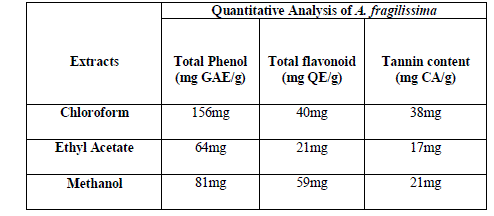 |
| Bacillus subtilis. Natural antioxidants are not limited to be rich source of natural antioxidant compounds. The total phenol content was measured as Gallic acid equivalent (GAE) g of extract. The total phenolic contents of dried different solvent extracts of seaweed is obtained in this study are presented in (fig). The total phenolic contents of studied seaweed ranged from 64 mg GAE/g to 156 mg GAE/g. The higher phenolic content was found to be 156 mg GAE/g of chloroform extract of A. fragilissima, whereas methanol extract of A. fragilissima had 81 mg GAE/g, and the least phenol content was found to be in the ethyl acetate extract of the A. fragilissima which had 64 mg GAE/g. |
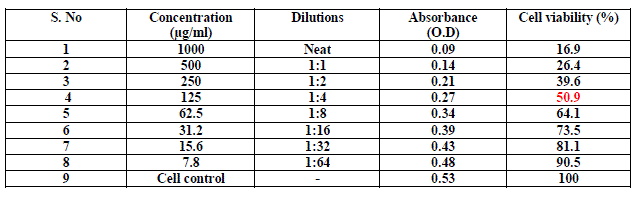 |
| The total flavonoid content was measured as Quercetin equivalent (QE) g of extract. The total flavonoids of the dried seaweed extract are presented in Table 3. Total flavonoids in the seaweed ranged from 21 mg QE/g to 59 mg QE/g. The methanol extract of the A. fragilissima contained higher total flavonoid content which was found to be 59 mg QE/g than the other extracts comparatively. The chloroform extract of the A. fragilissima was found to have 40 mg QE /g of total flavonoid content and the lowest total flavonoid content was found in ethyl acetate extract of A. fragilissima which had 21 mg QE/g respectively. |
| The total condensed tannin content was measured as Catechin equivalent (CE) of the extract. Total condensed tannin content of dried methanol, ethyl acetate and chloroform extract of A. fragilissima can be seen in table 3. The condensed tannin content of the studied seaweed ranged from 17 mg CE/g to 38 mg CE/g. The chloroform extract of A. fragilissima found to have higher amount of condensed tannin which was 38 mg CE/g, and methanol extract of A. fragillissima was found to have 21 mg CE/g of total condensed tannin content. The lowest amount of condensed tannin content was found in ethyl acetate extract of the A .fragillissima which was 17 mg CE/g respectively. |
| ANTIOXIDANT ACTIVITY OF A. FRAGILISSIMA |
| DPPH radical scavenging activity |
| DPPH reagent has been used extensively for investigating the free radical scavenging activities of compounds. In the DPPH test, the dried extracts are potentially able to produce the yellow coloured diphenylpicrylhydrazine. The assay is based on the reduction of alcoholic DPPH solution in the presence of hydrogen – donating antioxidant due to the formation of the non-radical form DPPH-H by the reaction. DPPH results are often interpreted as the “Inhibition Concentration” or IC50 value, which is defined as the concentration of substrate that causes 50% loss of the DPPH activity. |
| The IC50 values of DPPH radical scavenging activity from the dried seaweeds of different solvent extracts are presented in Fig 1. The antioxidant activities of all the three different extract were significantly different and IC50 values ranged from 50μg to 200 μg/ mL. Chloroform and Methanol extract of A. fragilissima, showed highest activity achieving 50% inhibition of DPPH radical at a concentration as low as 50 to 75 μg/ mL. Ethyl acetate had an IC50 level of 50 to 200 μg/ mL. These results are substantially less effective than that of all the three species of seaweeds in the present study which shows that the Gulf of Mannar seaweeds have good potential as a source of natural antioxidants. |
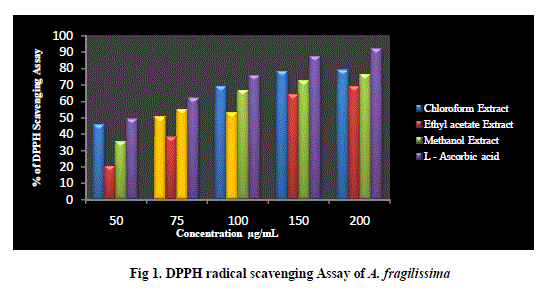 |
| REDUCING POWER ASSAY |
| In this assay the yellow color of the test solution changes to various shades of green and blue depending on the reducing power of each compound. The presence of reducer (i.e. antioxidants) causes the reduction of the fe3+/ferric cyanide complex to the ferrous form. The reducing activity of various solvent extract of A. fragilissima was evaluated according to the method of Yamaguchi et al., 1998. The concentration of each extract was prepared from 50 to 200μg/mL. The highest amount of reducing power was observed in methanol extract of A.fragilissima which was 0.186 at 200 μg/mL concentration, followed by ethyl acetate extract which was 0.142μg/mL at the concentration of 200μg/mL. The minimum reducing power was exhibited by chloroform extract of A.fragilissima which was 0.043 at 200μg/mL fig 2. |
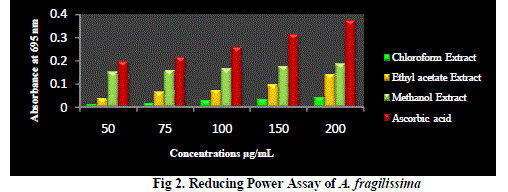 |
| HYDROGEN PEROXIDE SCAVENGING ASSAY |
| The measurement of H2O2 scavenging activity is one of the useful methods of determining the ability of antioxidants to decrease the level of pro-oxidants such as H2O2. It can cross membranes and may slowly oxidize a number of compounds. Hydrogen peroxide itself is not very reactive, but sometimes it can be toxic to cells because of rise in the hydroxyl in the cells. The inhibitive effect of seaweed extract of A. fragilissima was subjected to hydrogen peroxide scavenging assay. The concentration of each extract was prepared from 50 to 100μg/mL. Among the three different extracts the chloroform extract has showed the greater ability to decrease the pro-oxidant H2O2 which was 82.97% at the concentration of 200 μg/mL followed by ethyl acetate extract which had 76.62% at the same concentration. The minimal activity was determined to be 69.96 % at the concentration of 200 μg/mL of methanol extract of A. fragilissima fig.3 respectively. |
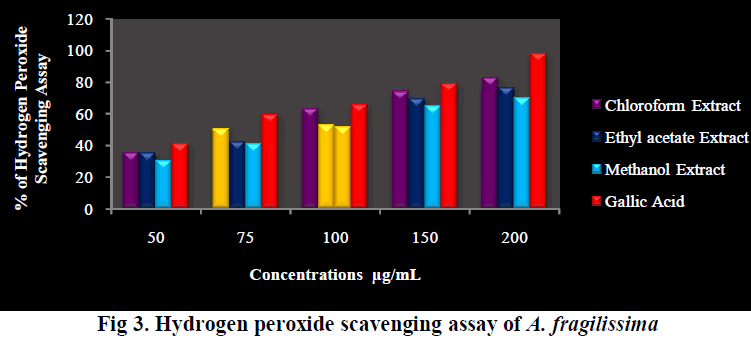 |
| METAL CHELATING ASSAY |
| The measurement of chelating effect on iron indicates high antioxidant activity. Ferrozine can form complex with ferrous ion quantitatively. In the complex formation is disrupted and thus a decrease in the red colour complex can be measured. The concentration of three different extracts was prepared from 50 to 200μg/mL. The highest chelating effect was found to be in methanol extract of the A. fragilissima which was 73.63% and the least was found to be 61.13% Ethyl acetate. The chelating effect increased as the concentration of extracts increased respectively fig 4. |
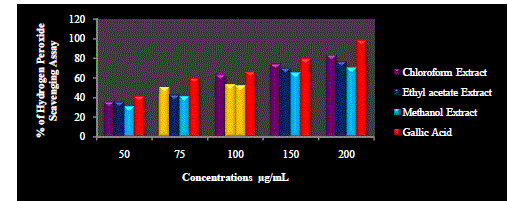 |
| TOTAL ANTIOXIDANT CAPACITY (TAC) |
| The reducing properties are generally associated with the presence of reductions. Reductions were reported to be terminators of free radical chain reactions by donating a hydrogen atom. In most cases, irrespective of the stage in the oxidative action is assessed, most non-enzymatic anti-oxidative activity is mediated by redox reactions. In the present study the reducing power of the seaweed extract of A. fragilissima increases with increasing concentration. The concentration of each extract was prepared from 50 to 200μg/mL. The strongest reducing power was concentrated in the methanol extract of the A.fragilissima which was indicated to be 0.347 at the concentration of 200μg/mL followed by chloroform extract which was 0.093 at the same concentration. The minimum reducing capacity was found to be 0.013μg/mL in the ethyl acetate extract of A. fragilissima respectively fig 5. |
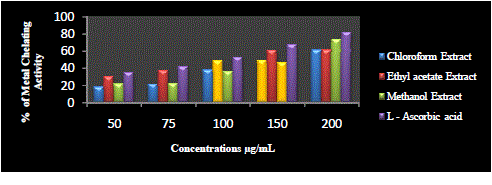 |
| ABTS INHIBITION ASSAY |
| The ABTS radical reactions involve electron transfer and the process take place faster rate when compared to DPPH and Hydrogen peroxide. In this study the ABTS radical scavenging activity was (55.52%) in 1000μg/mL of concentration (fig. 6) when compared DPPH and Hydrogen peroxide respectively. |
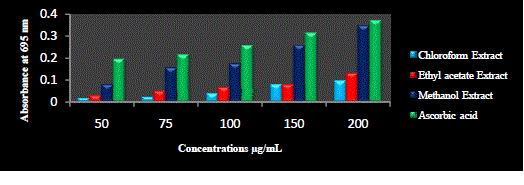 |
| ANTICANCER ACTIVITY OF METHANOL EXTRACT OF A. FRAGILISSIMA (MTT assay) |
| Anticancer activities were evaluated in order to elucidate the effect of extracts is directly correlated to the induction of cell death or the suppression of cell proliferation. The results of the activity of organic extracts are summarized in tables 7, 8 & 9. The Anticancer activity of Methanol extract of A. fragilissima at different concentrations ranged from 7.8 to 1000 μg/ ml of extract were evaluated by MTT assay as described by Mossmann 1983. |
| Anticancer effect of Methanol extract of A. fragilissima was observed in Lung Cancer Cell Line. The cell viability was found increased at lower concentration (7.8μg/mL) of the extract but found to be decreased by increasing concentration of the extract in all the three seaweeds. The LC 50 (Lethal concentration) of methanol extract was observed at 125 μg/mL concentration of the extract. Whereas, only 16.9% cell viability was observed at 1 mg/ml concentration 7, 8 & 9. |
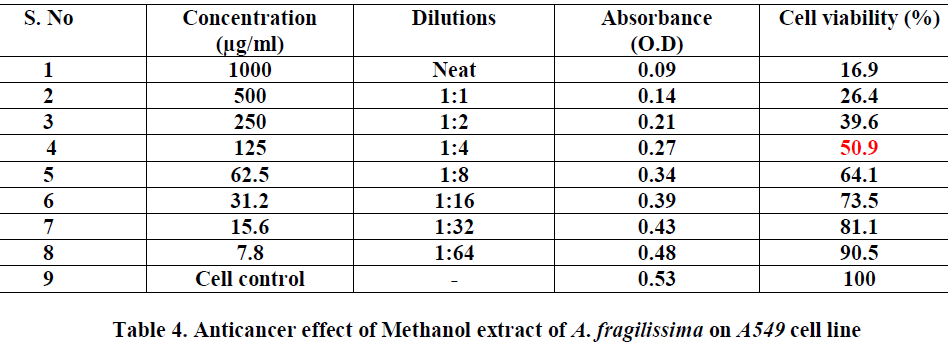 |
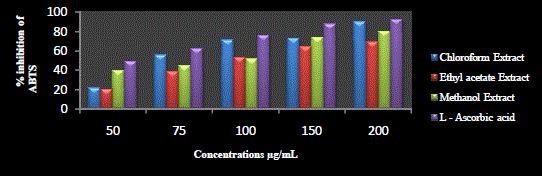 |
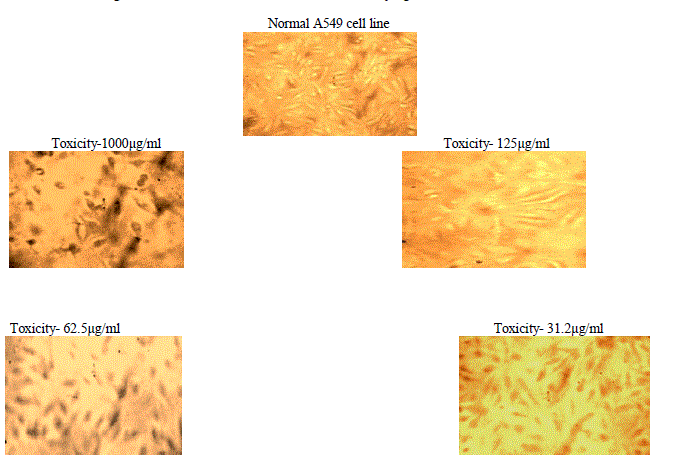 |
 |
DISCUSSION |
| Today seaweeds are the raw materials for many industrial productions like agar, algin and carrageenan but they continue to be widely consumed as food in Asian countries (Mishra 1993). The common major compounds like proteins, carbohydrates, steroids, glycosides can be extracted using polar solvents such as Methanol, Ethyl acetate and Chloroform during Phytochemical process. These results were compared with the recently reported qualitative phytochemical tests which were used to detect the presence of alkaloids, tannins, saponins, flavonoids, glycosides and phenols from the seaweeds.Marine genus synthesizes active constituents which are used in traditional and complementary medicine. Different varieties of marine algae were reported to contain active ingredients that can cure diseases. Nowadays, higher percentage of population prefer to use remedies of natural origin for curing illness as these claimed to produce less side effects (Tyagi and Bohra et al., 2002). The present study was focused on three different extract of A. fragilissima for the presence of phytochemical substances, powder elemental analysis and antibacterial activity against Gram-positive and Gram-negative bacteria. Algae are eukaryotic organisms inhabited in salty sea water and Recognized to synthesize several bioactive (Michael et al., 2002) compounds which show antimicrobial property. In addition, other substances identified as antimicrobial agents were acrylic microbial acid, terpenes, sulphur containing heterocyclic compounds and phenolic inhibitors. |
| Phytochemical screening of A. fragilissima revealed the presence of carbohydrates and alkaloids where as saponins, phytosterols and glycosides were found only in ethyl acetate and methanol extracts. Alkaloids are commonly found to have antimicrobial properties (Omulokoli et al., 1997) against both Gram-positive and Gram-negative bacteria. In conclusion, the preliminary Phytochemical screening of A. fragilissima indicates the presence of chemical constituents playing an indispensable role in antibacterial activity. The findings of this study also pave the way for further research to identify the specific active compounds that are responsible for its claimed antibacterial activity. Antibacterial activity of red, brown and green algae against both Gram positive and Gram negative bacteria has been established by several scientists (Kolanjinathan et al., 2009). But variation in antibacterial activity may be due to the method of extraction, solvent used in extraction and season at which samples were collected (Kandhasamy and Arunachalam, 2008). Several different organic solvents have been used to screen algae for antibacterial activity. Early, Sastry and Rao (1994) showed antibacterial activity against Gram-positive and Gram-negative pathogenic strains after successive extraction with benzene, chloroform and methanol. Kolanjinathan and Ganesh (2009) indicated that acetone was the best solution for extracting the effective antimicrobial materials from Sargassum myricystum, Turbinaria conoides, Hypnea musiformis, Gracilaria edulis and Halimedia gracilis; whereas, Karthikaidevi et al. (2009) used seven different solvents including methanol and ethyl acetate for extraction of antibacterial substances from Codium adherens, Ulva reticulata and Halimeda tuna. |
| In our study, three different solvent extract marine algae were collected from the coast of Kilakarai, Rameswaram, Tamil Nadu and were screened for their antibacterial activities using the solvents methanol, ethyl acetate and Chloroform. The results showed that, A. fragilissima, member of red algae, Methanol extract were more active compared with Chloroform and Ethyl acetate extract. Similar results were also obtained by Kandhasamy and Arunachalam (2008) and Karthikaidevi et al. (2009). These strong activities related to brown algae may be due to the phenolic compounds such as phlorotannins, eckol and eckol-related compounds that have strong bactericidal activity. Antibacterial activities of seaweeds varied with the species from different division; Caccamese et al. (1985) have reported that brown algal extracts showed higher activity than the extracts of red algae which was in accordance with our results, whereas Viachosi et al. (2001) reported that extracts of the Phaeophyta exhibited the highest level of antibacterial activity, followed by the Rhodophyta and then the Chlorophyta. In contrast, Yi et al. (2001) reported that species of Rhodophyta showed the highest antibacterial activity. Of the three solvents tested, methanol was determined to be the best solvent for isolation of antimicrobial compounds from the tested marine algae followed by ethyl acetate and Chloroform (Table 2). Among marine the algal extracts tested, some appeared to be specific in their activity against several test bacteria. This point may be important for the development of specific antibiotics, and further work is needed to identify the compounds causing the activity, to evaluate specific antimicrobial activity against pathogenic bacteria especially those causing the human diseases. |
| Phenolic compounds are commonly found in plants, including seaweeds, and have been reported to have a wide range of biological activities including antioxidant properties (Kuda et al., 2007). The Folin-Ciocalteu method was applied to study the total phenolic content of the seaweeds. Folin-Ciocalteu reagent determines total phenols, producing blue colour by reducing yellow heteropolyphosphomolybate-tungstate anions (Athukorala et al., 2006). The total phenolic contents of different extracts of three seaweeds as obtained in this study are presented in Table 3. Reports have revealed that phenolic compounds are one of the most effective antioxidants in brown algae. The total phenolic content results of H. elongata and L. saccharina obtained in this study were higher than some reports for other brown seaweeds. Ganesan et al. (2008) reported crude methanolic extracts of red seaweeds to yield results in the range of 1.5 to 4.1 mg GAE/g, which is lower phenolic contents than the red species studied in this work. The results of the present study are promising as algal polyphenolic compounds are effective antioxidants in delaying oil rancidity, therefore the seaweed extracts could have potential in food applications. In our present study, the total flavonoids of the dried seaweeds extracts are presented in Table 3. Total flavonoids in the seaweeds ranged from 21 to59 mg QE/g. Methanol extract of, A. fragilissima contained significantly higher total flavonoids content which was found to be 59 mg QE/g. Kahkonen et al. (1999) stated that flavonoids are probably the most important natural phenolic due to their broad spectrum of chemical and biological activities, including antioxidant and free radical scavenging properties. Flavonoids have been reported as antioxidants, scavengers of a wide range of reactive oxygen species and inhibitors of lipid peroxidation, and also as potential therapeutic agents against a wide variety of diseases. |
| Seaweeds or marine macro algae have been known as rich sources of various natural antioxidants. Compounds such as polyphenols, catechin, flavonols, flavonol glycosides, and phlorotannins have been discovered from methanol extract of red and brown algae. The uniqueness of their molecular skeleton and structures has contributed to the strong antioxidant activity. Polyphenols for instant uses its phenol rings as electron traps for free radicals. The antioxidant activities of all the three different seaweeds were significantly different and IC50 values ranged from 50 μg to 200 μg/ mL. Methanol and Chloroform extract of A. fragilissima showed highest activity achieving 50% inhibition of DPPH radical at a concentration as low as 75μg/ mL. The results of the present study are in line with Wang et al. (2009) and Yan et al. (1999), who also found that brown algae contained higher amounts of polyphenols and DPPH radical scavenging activity than red and green algae. However, Chandini et al. (2008) reported low levels of DPPH radical scavenging activity in brown seaweeds, in the range of 17.79 to 23.16% at an extract concentration of 1000 μg/ml. |
| Antioxidant activity of marine algae may arise from pigments such as chlorophylls and carotenoids, vitamin and vitamin precursors including α-tocopherol, β-carotene, niacin, thiamine and ascorbic acid, phenolic such as polyphenolic and hydroquinones and flavonoids, phospholipids particularly phosphatidylcholine, terpenoids, peptides, and other antioxidative substances, which directly or indirectly contribute to the inhibition or suppression of oxidation processes (Shahidi, 2008).The dried methanolic extracts of three brown species of seaweeds were found to have good antioxidant and antimicrobial activity. Although a variety of solvents have been employed in screening algae for antioxidant and antimicrobial activity, it is still uncertain what kind of solvent is the most effective and suitable for extraction from seaweeds (Zheng et al., 2001). In order to potentially enhance the antioxidant and antimicrobial content from red and green species, ethyl acetate and hexane were utilized as extraction solvents. Phenolic compounds are generally more soluble in polar organic solvents than in water, therefore the effective extractants recommended are aqueous mixtures of methanol, ethyl acetate and hexane (Waterman and Mole, 1994). With such polar solvents, phenolic compounds which are attached to sugar or protein, saponins, glycosides, organic acids, tannins, salts, and mucus can be extracted. |
| As discussed, methanol extracts of red and green seaweeds had higher or the same total phenolic content and DPPH radical scavenging activity as ethanol and acetone extracts. This implies that the bioactive metabolite in the algae might be readily soluble in methanol and slightly more sparingly soluble in ethyl acetate and hexane. Extracts of red seaweeds have been reported to exhibit weak DPPH radical quenching activity when obtained using water, ethanol or methanol as solvents, while chloroform, ethyl acetate and acetone extracts from several red seaweeds have been reported to exhibit strong DPPH quenching activity (Yan et al., 1999). |
| Therefore, the particular solvent used to extract the seaweed material will have a dramatic effect on the compounds in the extract recovered. For example, the non polar fraction from chloroform: methanol extraction of Porphyra tenera exhibited a significant protective effect against lipid oxidation associated with phospholipids such as, phosphatidyl choline and phosphatidyl ethanolamine. Nakayama et al. (1999) reported that hexane, chloroform and methanol extracts of red seaweed, Porphyra yezoensis exhibited antioxidant activities attributed to the presence of β- carotene, chlorophyll analogues and amino compounds. Overall, methanol was the most effective solvent for extraction of antioxidant properties from seaweeds, which may be due to methanol having a higher dielectric constant than ethyl acetate and hexane. The reducing power property indicates that the antioxidant compounds are electron donors and can reduce the oxidized intermediates of the lipid peroxidation process, so that they can act as primary and secondary antioxidants (Yen and Chen 1995). We found that the red seaweed, methanol extract of A. fragilissima were more reactive than the other extracts. The positive control L - Ascorbic acid was showed significantly higher antioxidant activity than all the extract of seaweed sample. |
| Anticancer effect of methanol extract of A. fragilissima was observed in Lung Cancer Cell Line. The cell viability was found increased at lower concentration (7.8μg/mL) of the extract but found to be decreased by increasing concentration of the extract in all the three seaweeds. Moreover, the anticancer effects of the dulse and kelp extracts were positively correlated with the total polyphenol contents of the extracts. Thus it is correlated with the dulse and kelp extracts exhibited dose-dependent inhibition against the proliferation of the human cervical epithelial adenocarcinoma HeLa cell line in the present study. The EC50 values calculated for P. palmata, L. setchellii, M. integrifolia and N. leutkeana extract inhibition of HeLa cell proliferation after 72 h incubation were 2.30, 4.53, 4.11 and 4.10 mg/mL, respectively (Yvonne Yuan 2006). |
CONCLUSION |
| The results of the present study indicated that the collected seaweeds; A. fragilissima successfully displayed Phytochemical analysis, antioxidant and antimicrobial activities and contained phenolic, and flavonoids. Methanol extract of A. fragilissima had the highest antimicrobial and antioxidant content. The extraction of antimicrobials from the species of seaweed was solvent dependent. The antioxidant content of the A. fragilissima did not vary significantly with different polar solvents. This is a promising finding, as there may be a potential to utilize such extracts in medicines to act as antioxidants which could enhance quality, and also as antimicrobial agents, which could potentially increase the shelf life and safety. |
| Currently, about 50% of drugs used in clinical trials for anticancer activity were isolated from natural sources such as marine algae (Seaweeds) herbs and spices or related to them. A number of active compounds such as flavonoids, diterpenoids, triterpenoids and alkaloids have been shown to possess anticancer activity. According to the report of the American National Cancer Institute (NCI), the criterion of anticancer activity for the crude extracts of herbs is an IC50<30 μg/ml. Thus, according to the results from current study seems that marine algae could be employed in ethno-medicine in the treatment of cancerous diseases. There are some limitations of this study. Relationship between flavonoids concentration and antioxidant activity were not determined. Moreover, only cytotoxicity was determined but apoptosis and cell cycle analysis were not performed. Our results in this study indicate that some compounds in A. fragilissima have anticancer activities and may contribute in the therapeutic effect of these medicinal properties. However, there is a need of detailed scientific study on traditional medical practices to ensure that valuable therapeutic knowledge of some seaweed is preserved and also to provide scientific evidence for their efficacies. |
ACKNOWLEDGEMENT |
| Authors are grateful to Prof. R. Rengasamy, Director, Centre for Advanced Studies in Botany, University of Madras, Maraimalai Campus, Guindy, Chennai- 600 025, Tamil Nadu, India for providing laboratory facilities and for his constant support and encouragement during the course of study period |
References |
|